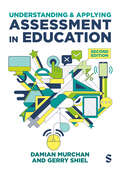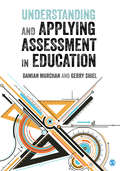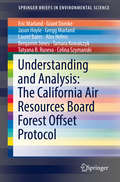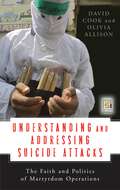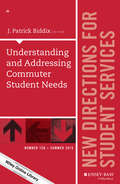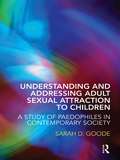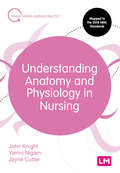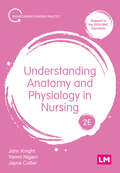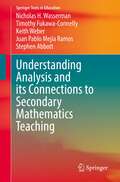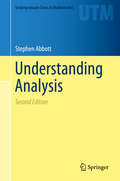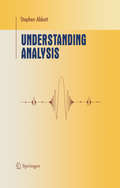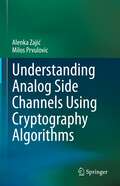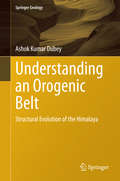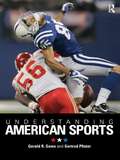- Table View
- List View
Understanding and Applying Assessment in Education
by Damian Murchan Gerry ShielAll teachers are responsible for assessing the children they teach, and the outcomes of any assessment are important for individual learners, schools and wider education systems. Designed as a pragmatic guide for new teachers and those training to teach, this book is your one-stop-shop for understanding assessment in schools. It covers formative and summative approaches used across primary and secondary education, supporting a balanced overview with policy examples drawn from the UK, Ireland and wider international contexts. This updated second edition reflects recent trends in assessment and includes: more balanced coverage across primary and secondary age phases with a broader range of examples across curriculum subject areas a new chapter on the potential of digital assessment for both formative and summative purposes the impact of the COVID-19 pandemic on assessment in general, and examinations in particular Damian Murchan is Associate Professor in the School of Education at Trinity College Dublin. Gerry Shiel is a Research Fellow at the Educational Research Centre, Dublin, Ireland.
Understanding and Applying Assessment in Education
by Dr Damian Murchan Dr Gerry ShielAll teachers are responsible for assessing the children they teach and the outcomes of any assessment are important for individual learners and the wider school. This book is your one-stop-shop for understanding assessment in schools. It covers formative and summative approaches used across primary and secondary education, supporting a balanced overview with policy examples drawn from the UK, Ireland and wider international contexts. Designed as a pragmatic handbook for new teachers and those training to teach, the book discusses key principles of assessment, before providing guidance on developing and carrying out assessment in the classroom, and looking at how assessment information can be used to benefit your teaching and the children you teach.
Understanding and Applying Assessment in Education
by Dr Damian Murchan Dr Gerry ShielAll teachers are responsible for assessing the children they teach and the outcomes of any assessment are important for individual learners and the wider school. This book is your one-stop-shop for understanding assessment in schools. It covers formative and summative approaches used across primary and secondary education, supporting a balanced overview with policy examples drawn from the UK, Ireland and wider international contexts. Designed as a pragmatic handbook for new teachers and those training to teach, the book discusses key principles of assessment, before providing guidance on developing and carrying out assessment in the classroom, and looking at how assessment information can be used to benefit your teaching and the children you teach.
Understanding and Analysis: The California Air Resources Board Forest Offset Protocol (SpringerBriefs in Environmental Science)
by Eric Marland Grant Domke Jason Hoyle Gregg Marland Laurel Bates Alex Helms Benjamin Jones Tamara Kowalczyk Tatyana B. Ruseva Celina SzymanskiThis book is a product of the initial phase of a broader study evaluating the voluntary and regulatory compliance protocols that are used to account for the contributions of forests in U.S.-based greenhouse gas (GHG) mitigation programs. The research presented here is particularly concerned with these protocols’ use of the USDA Forest Service’s Forest Inventory and Analysis (FIA) data to describe forest conditions, ownership, and management scenarios, and is oriented towards providing regulators and other interested parties with an objective comparison of the options, uncertainties, and opportunities available to offset GHG emissions through forest management. Chapters focus on the protocols for recognizing forest carbon offsets in the California carbon cap-and-trade program, as described in the Compliance Offset Protocol; U.S. Forest Projects (California Air Resources Board, 2011).Readers will discover the protocols used for quantifying the offset of GHG emissions through forest-related project activity. As such, its scope includes a review of the current methods used in voluntary and compliance forest protocols, an evaluation of the metrics used to assign baselines and determine additionality in the forest offset protocols, an examination of key quantitative and qualitative components and assumptions, and a discussion of opportunities for modifying forest offset protocols, in light of the rapidly changing GHG-related policy and regulatory environment. Finally, the report also discusses accounting and policy issues that create potential barriers to participation in the California cap-and-trade program, and overall programmatic additionality in addressing the needs of a mitigation strategy.
Understanding and Addressing Suicide Attacks: The Faith and Politics of Martyrdom Operations (Praeger Security International)
by David Cook Olivia AllisonDuring the past several years, Americans have witnessed the frequent occurrence of suicide attacks by radical Muslim groups. The public has wondered what drives someone to kill himself specifically in order to wreak havoc and destruction. While other works address the subject, many entirely ignore the ideological, religious, and cultural appeal of suicide attacks, and none can adequately speak to why certain groups choose to use suicide as a weapon while others do not. Beginning with a careful consideration of the religious and historical reasons, and the justifications that perpetrators find therein, for suicide operations, the authors reveal how radical groups have co-opted various aspects of their faith to provide fuel for their current activities.Established policy makers seem helpless to confront this destructive terrorist activity, often implying that countermeasures are ineffective and seeming to say we will just have to wait out the phenomenon. Even such a well-documented policy report as the 9/11 Commission's report failed to address the root of suicide attacks, only critiquing technical aspects of the U.S. security system. Focusing on specific attacks, their roots, their perpetrators, and their outcomes, the authors are able to shed light on this resurgence of radical religious forces that encourage the use of such tactics, and to propose new initiatives and approaches to handling such attacks before and after they occur.
Understanding and Addressing Commuter Student Needs: New Directions for Student Services, Number 150 (J-B SS Single Issue Student Services)
by J. Patrick BiddixDespite representing a majority of the college student population, a surprising lack of research has focused on the unique issues and needs of commuter students. This volume reviews the contemporary research and thinking about commuters. Topics include: • theoretical perspectives and discussions of foremost topics and issues, • specific examples for applying contemporary research with students of color, students with disabilities, and online students, • perspectives for immediate work and strategic planning, and • practical applications, recommendations, and suggestions for supporting commuter students. The volume has four major sections: theory, profiles and issues, support and services, and general applications.This is the 150th volume of this Jossey-Bass higher education quarterly series. An indispensable resource for vice presidents of student affairs, deans of students, student counselors, and other student services professionals, New Directions for Student Services offers guidelines and programs for aiding students in their total development: emotional, social, physical, and intellectual.
Understanding and Addressing Commuter Student Needs: New Directions for Student Services, Number 150 (J-B SS Single Issue Student Services)
by J. Patrick BiddixDespite representing a majority of the college student population, a surprising lack of research has focused on the unique issues and needs of commuter students. This volume reviews the contemporary research and thinking about commuters. Topics include: • theoretical perspectives and discussions of foremost topics and issues, • specific examples for applying contemporary research with students of color, students with disabilities, and online students, • perspectives for immediate work and strategic planning, and • practical applications, recommendations, and suggestions for supporting commuter students. The volume has four major sections: theory, profiles and issues, support and services, and general applications.This is the 150th volume of this Jossey-Bass higher education quarterly series. An indispensable resource for vice presidents of student affairs, deans of students, student counselors, and other student services professionals, New Directions for Student Services offers guidelines and programs for aiding students in their total development: emotional, social, physical, and intellectual.
Understanding and Addressing Adult Sexual Attraction to Children: A Study of Paedophiles in Contemporary Society
by Sarah D. GoodePaedophiles exist and we must develop ways of living with this fact whilst ensuring that children are kept safe. This ground-breaking book demystifies the field of adult sexual attraction to children, countering the emotionality surrounding the topic of paedophilia in the popular media by careful presentation of research data and interview material. Addressing how we can work together to reduce sexual offending in this population, this text bridges the gulf in understanding between those who want to protect children and those who feel sexual attraction to children – and recognises that they are sometimes the same people. Sarah D. Goode provides an overview of the topic by defining the term 'paedophile' and discussing how many adults there may be in the general population who find themselves sexually attracted to children. She looks at how the Internet has acted as an enabler, with an explosion of child pornography and 'pro-paedophile' websites. Drawing on data from a sample of fifty-six self-defined paedophiles living in the community, she explores themes including self-identity, the place of fantasy and the forms of support available to paedophiles. Her research highlights the scale of debate within the 'online paedophile community' about issues such as the morality of sexual contact with children and encouragement to maintain a law-abiding lifestyle. Throughout, she draws careful distinctions between sexual attraction to children and sexual contact with children. The book concludes with a valuable discussion on how adult sexual contact harms children and examples of a range of initiatives which work to protect children and prevent offending. Suitable for all professionals who work with children or sexual offenders, this book gives clear guidance on what one needs to know and do to ensure children are kept safe. It will also be of interest to students studying child protection, paedophilia and child sexual abuse within other social science disciplines.
Understanding and Addressing Adult Sexual Attraction to Children: A Study of Paedophiles in Contemporary Society
by Sarah D. GoodePaedophiles exist and we must develop ways of living with this fact whilst ensuring that children are kept safe. This ground-breaking book demystifies the field of adult sexual attraction to children, countering the emotionality surrounding the topic of paedophilia in the popular media by careful presentation of research data and interview material. Addressing how we can work together to reduce sexual offending in this population, this text bridges the gulf in understanding between those who want to protect children and those who feel sexual attraction to children – and recognises that they are sometimes the same people. Sarah D. Goode provides an overview of the topic by defining the term 'paedophile' and discussing how many adults there may be in the general population who find themselves sexually attracted to children. She looks at how the Internet has acted as an enabler, with an explosion of child pornography and 'pro-paedophile' websites. Drawing on data from a sample of fifty-six self-defined paedophiles living in the community, she explores themes including self-identity, the place of fantasy and the forms of support available to paedophiles. Her research highlights the scale of debate within the 'online paedophile community' about issues such as the morality of sexual contact with children and encouragement to maintain a law-abiding lifestyle. Throughout, she draws careful distinctions between sexual attraction to children and sexual contact with children. The book concludes with a valuable discussion on how adult sexual contact harms children and examples of a range of initiatives which work to protect children and prevent offending. Suitable for all professionals who work with children or sexual offenders, this book gives clear guidance on what one needs to know and do to ensure children are kept safe. It will also be of interest to students studying child protection, paedophilia and child sexual abuse within other social science disciplines.
Understanding Anatomy and Physiology in Nursing (Transforming Nursing Practice Series)
by John Knight Yamni Nigam Jayne CutterCovering all the key aspects of anatomy and physiology that nursing students need to know, this text is the go to book for aspiring nurses. From an overview of cells, blood and how organ systems work together, through to coverage of each of the major organ systems, all the way to key developmental stages, genetics and ageing, this book distils the vast amounts of anatomy and physiology information that student nurses need to know into short, concise and easily accessible chapters. Throughout the book, case studies link core principles of anatomy and physiology to scenarios commonly encountered by nurses in clinical practice, helping students to apply this knowledge to their everyday working life. Key features • Mapped to the new NMC standards of proficiency for registered nurses (2018) • Case studies, activities and other learning features help students translate the theory to practice • Provides revision guidance and strategies for tackling exams and assessments throughout
Understanding Anatomy and Physiology in Nursing (Transforming Nursing Practice Series)
by John Knight Yamni Nigam Jayne CutterCovering all the key aspects of anatomy and physiology that nursing students need to know, this text is the go to book for aspiring nurses. From an overview of cells, blood and how organ systems work together, through to coverage of each of the major organ systems, all the way to key developmental stages, genetics and ageing, this book distils the vast amounts of anatomy and physiology information that student nurses need to know into short, concise and easily accessible chapters. Throughout the book, case studies link core principles of anatomy and physiology to scenarios commonly encountered by nurses in clinical practice, helping students to apply this knowledge to their everyday working life. Key features • Mapped to the new NMC standards of proficiency for registered nurses (2018) • Case studies, activities and other learning features help students translate the theory to practice • Provides revision guidance and strategies for tackling exams and assessments throughout
Understanding Anatomy and Physiology in Nursing (Transforming Nursing Practice Series)
by John Knight Yamni Nigam Jayne CutterCovering all the key aspects of anatomy and physiology that nursing students need to know, this text is the go to book for aspiring nurses. From an overview of cells, blood and how organ systems work together, through to coverage of each of the major organ systems, all the way to key developmental stages, genetics and ageing, this book distils the vast amounts of anatomy and physiology information that student nurses need to know into short, concise and easily accessible chapters. Throughout the book, case studies link core principles of anatomy and physiology to scenarios commonly encountered by nurses in clinical practice, helping students to apply this knowledge to their everyday working life. Key features • Mapped to the new NMC standards of proficiency for registered nurses (2018) • Case studies, activities and other learning features help students translate the theory to practice • Provides revision guidance and strategies for tackling exams and assessments throughout
Understanding Anatomy and Physiology in Nursing (Transforming Nursing Practice Series)
by John Knight Yamni Nigam Jayne CutterCovering all the key aspects of anatomy and physiology that nursing students need to know, this second edition condenses vast amounts of scientific information into short, concise, and easily accessible chapters. It introduces aspiring nurses to all of the vital information on this tricky subject, from an overview of cells, blood, and the major organ systems through to key developmental stages, genetics and ageing. Case studies link core principles of anatomy and physiology to common real-world clinical scenarios, helping students apply this knowledge to their everyday working practice. Key features: - Each short chapter is mapped to the 2018 NMC Standards - Scientific information is broken down into easily digestible chunks with accompanying illustrations, to help aspiring nurses get to grips with this complex subject - Case studies, activities and other learning features help students translate the theory to practice - Provides revision guidance and strategies for tackling exams and assessments
Understanding Anatomy and Physiology in Nursing (Transforming Nursing Practice Series)
by John Knight Yamni Nigam Jayne CutterCovering all the key aspects of anatomy and physiology that nursing students need to know, this second edition condenses vast amounts of scientific information into short, concise, and easily accessible chapters. It introduces aspiring nurses to all of the vital information on this tricky subject, from an overview of cells, blood, and the major organ systems through to key developmental stages, genetics and ageing. Case studies link core principles of anatomy and physiology to common real-world clinical scenarios, helping students apply this knowledge to their everyday working practice. Key features: - Each short chapter is mapped to the 2018 NMC Standards - Scientific information is broken down into easily digestible chunks with accompanying illustrations, to help aspiring nurses get to grips with this complex subject - Case studies, activities and other learning features help students translate the theory to practice - Provides revision guidance and strategies for tackling exams and assessments
Understanding Anatomy and Physiology in Nursing (Transforming Nursing Practice Series)
by John Knight Yamni Nigam Jayne CutterCovering all the key aspects of anatomy and physiology that nursing students need to know, this second edition condenses vast amounts of scientific information into short, concise, and easily accessible chapters. It introduces aspiring nurses to all of the vital information on this tricky subject, from an overview of cells, blood, and the major organ systems through to key developmental stages, genetics and ageing. Case studies link core principles of anatomy and physiology to common real-world clinical scenarios, helping students apply this knowledge to their everyday working practice. Key features: - Each short chapter is mapped to the 2018 NMC Standards - Scientific information is broken down into easily digestible chunks with accompanying illustrations, to help aspiring nurses get to grips with this complex subject - Case studies, activities and other learning features help students translate the theory to practice - Provides revision guidance and strategies for tackling exams and assessments
Understanding Analysis and its Connections to Secondary Mathematics Teaching (Springer Texts in Education)
by Nicholas H. Wasserman Timothy Fukawa-Connelly Keith Weber Juan Pablo Mejía Ramos Stephen AbbottGetting certified to teach high school mathematics typically requires completing a course in real analysis. Yet most teachers point out real analysis content bears little resemblance to secondary mathematics and report it does not influence their teaching in any significant way. This textbook is our attempt to change the narrative. It is our belief that analysis can be a meaningful part of a teacher's mathematical education and preparation for teaching. This book is a companion text. It is intended to be a supplemental resource, used in conjunction with a more traditional real analysis book.The textbook is based on our efforts to identify ways that studying real analysis can provide future teachers with genuine opportunities to think about teaching secondary mathematics. It focuses on how mathematical ideas are connected to the practice of teaching secondary mathematics–and not just the content of secondary mathematics itself. Discussions around pedagogy are premised on the belief that the way mathematicians do mathematics can be useful for how we think about teaching mathematics. The book uses particular situations in teaching to make explicit ways that the content of real analysis might be important for teaching secondary mathematics, and how mathematical practices prevalent in the study of real analysis can be incorporated as practices for teaching.This textbook will be of particular interest to mathematics instructors–and mathematics teacher educators–thinking about how the mathematics of real analysis might be applicable to secondary teaching, as well as to any prospective (or current) teacher who has wondered about what the purpose of taking such courses could be.
Understanding Analysis (Undergraduate Texts in Mathematics)
by Stephen AbbottThis lively introductory text exposes the student to the rewards of a rigorous study of functions of a real variable. In each chapter, informal discussions of questions that give analysis its inherent fascination are followed by precise, but not overly formal, developments of the techniques needed to make sense of them. By focusing on the unifying themes of approximation and the resolution of paradoxes that arise in the transition from the finite to the infinite, the text turns what could be a daunting cascade of definitions and theorems into a coherent and engaging progression of ideas. Acutely aware of the need for rigor, the student is much better prepared to understand what constitutes a proper mathematical proof and how to write one.Fifteen years of classroom experience with the first edition of Understanding Analysis have solidified and refined the central narrative of the second edition. Roughly 150 new exercises join a selection of the best exercises from the first edition, and three more project-style sections have been added. Investigations of Euler’s computation of ζ(2), the Weierstrass Approximation Theorem, and the gamma function are now among the book’s cohort of seminal results serving as motivation and payoff for the beginning student to master the methods of analysis.
Understanding Analysis (Undergraduate Texts in Mathematics)
by Stephen AbbottThis elementary presentation exposes readers to both the process of rigor and the rewards inherent in taking an axiomatic approach to the study of functions of a real variable. The aim is to challenge and improve mathematical intuition rather than to verify it. The philosophy of this book is to focus attention on questions which give analysis its inherent fascination. Each chapter begins with the discussion of some motivating examples and concludes with a series of questions.
Understanding Analog Side Channels Using Cryptography Algorithms
by Alenka Zajić Milos PrvulovicThis book offers the latest research results on analog side channels and their usage in cybersecurity. It demystifies analog side channels and demonstrates new use cases for them. The first part of this book discusses how analog side channels are generated, the physics behind it, the modeling and measurements of analog side channels, and their analogies to wireless communication systems. The second part of this book introduces new applications that benefit from leveraging side channels. In addition to breaking cryptography algorithms, it demonstrates how analog side channels can be used for malware detection, program profiling, hardware profiling, hardware/software attestation, hardware identification, and hardware Trojan detection.Side channel is one of the methods for obtaining information about program execution. Traditionally, they are used in computer science to extract information about a key in cryptographic algorithms. What makes them different from other ways of extracting information about program execution is that side channels rely on how a system implements program execution, rather than what the program’s algorithm specifies. Analog side channels are particularly powerful because they are not easy to suppress or detect that someone is collecting information from the system. Although they are very powerful tools, they are poorly understood.This book targets advanced level students in computer science and electrical engineering as a textbook. Researchers and professionals working with analog side channels, how to model them, measure them, improve signal to noise ratio, and invent new signal processing techniques can also use this book. Computer scientists and engineers who want to learn new applications of side channels to improve system security, new techniques for breaking cryptography keys, new techniques for attestation, and new techniques for hardware Trojan detection will also want to purchase this book.
Understanding an Orogenic Belt: Structural Evolution of the Himalaya (Springer Geology)
by Ashok Kumar DubeyThe book provides a model for the structural evolution of the Himalaya with relevant background information making it easily accessible to earth scientists specializing in other areas. The book is divided into two parts: The first part describes the basic principles of structural geology that are required to understand the evolutionary model described in the second part. The book incorporates some of the commonly ignored structural features, such as Pre-Himalayan rift tectonics, reactivation of faults, simultaneous development of folds and thrust faults, superposed folds, strike-slip faults developed during early and superposed deformation, problems with GPS data, erratic crustal shortening obtained by restoration of deformed sections, etc. The proposed model is essentially based on inversion tectonics and provides answers to some previously unresolved questions. It describes in detail the structure of the Himalaya as a primary arc, with supporting evidence from model deformation under controlled boundary conditions and anisotropy of magnetic susceptibility studies.
Understanding American Sports
by Gerald R. Gems Gertrud PfisterSince the nineteenth century the USA has served as an international model for business, lifestyle and sporting success. Yet whilst the language of sport seems to be universal, American sports culture remains highly distinctive. Why is this so? How should we understand American sport? What can we learn about America by analyzing its sports culture? Understanding American Sports offers discussion and critical analysis of the everyday sporting and leisure activities of ‘ordinary’ Americans as well as the ‘big three’ (football, baseball, basketball), and elite sports heroes. Throughout the book, the development of American sport is linked to political, social, gender and economic issues, as well as the orientations and cultures of the multilayered American society with its manifold regional, ethnic, social, and gendered diversities. Topics covered include: American college sports the influence of immigrant populations the unique status of American football the emergence of women’s sport in the USA With co-authors from either side of the Atlantic, Understanding American Sports uses both the outsider’s perspective and that of the insider to explain American sports culture. With its extensive use of examples and illustrations, this is an engrossing and informative resource for all students of sports studies and American culture.
Understanding American Sports
by Gerald R. Gems Gertrud PfisterSince the nineteenth century the USA has served as an international model for business, lifestyle and sporting success. Yet whilst the language of sport seems to be universal, American sports culture remains highly distinctive. Why is this so? How should we understand American sport? What can we learn about America by analyzing its sports culture? Understanding American Sports offers discussion and critical analysis of the everyday sporting and leisure activities of ‘ordinary’ Americans as well as the ‘big three’ (football, baseball, basketball), and elite sports heroes. Throughout the book, the development of American sport is linked to political, social, gender and economic issues, as well as the orientations and cultures of the multilayered American society with its manifold regional, ethnic, social, and gendered diversities. Topics covered include: American college sports the influence of immigrant populations the unique status of American football the emergence of women’s sport in the USA With co-authors from either side of the Atlantic, Understanding American Sports uses both the outsider’s perspective and that of the insider to explain American sports culture. With its extensive use of examples and illustrations, this is an engrossing and informative resource for all students of sports studies and American culture.
Understanding American Power: The Changing World of US Foreign Policy
by Bryan MabeeThis broad-ranging assessment of US power in the twenty-first century covers not just the nature and mechanics of foreign policy but the broad array of economic, military, political, social and ideological forces that shape America's global position and role, all set in a clear historical context.
Understanding American Political Parties: Democratic Ideals, Political Uncertainty, and Strategic Positioning
by Jeffrey M. StonecashHow do parties respond to the electorate and craft winning strategies? In the abstract parties are the vehicles to make democracy work, but it is often difficult to see the process working as well as we think it might. Indeed, voters often struggle to see parties as the valuable vehicles of representation that so many academics describe. There is a clear discrepancy between the ideal expressed in many textbooks and the reality that we see playing out in politics. Noted scholar Jeffrey Stonecash gives us a big picture analysis that helps us understand what is happening in contemporary party politics. He explains that parties behave the way they do because of existing political conditions and how parties adapt to those conditions as they prepare for the next election. Parties are unsure if realignment has stabilized and just what issues brought them their current base. Does a majority support their positions and how are they to react to ongoing social change? Is the electorate paying attention, and can parties get a clear message to those voters? This book focuses on the challenges parties face in preparing for future elections while seeking to cope with current conditions. This coping leads to indecisiveness of positioning, simplification of issues, repetition of messages, and efforts to disparage the reputation of the opposing party. Stonecash sheds much needed light on why parties engage in the practices that frustrate so many Americans.
Understanding American Political Parties: Democratic Ideals, Political Uncertainty, and Strategic Positioning
by Jeffrey M. StonecashHow do parties respond to the electorate and craft winning strategies? In the abstract parties are the vehicles to make democracy work, but it is often difficult to see the process working as well as we think it might. Indeed, voters often struggle to see parties as the valuable vehicles of representation that so many academics describe. There is a clear discrepancy between the ideal expressed in many textbooks and the reality that we see playing out in politics. Noted scholar Jeffrey Stonecash gives us a big picture analysis that helps us understand what is happening in contemporary party politics. He explains that parties behave the way they do because of existing political conditions and how parties adapt to those conditions as they prepare for the next election. Parties are unsure if realignment has stabilized and just what issues brought them their current base. Does a majority support their positions and how are they to react to ongoing social change? Is the electorate paying attention, and can parties get a clear message to those voters? This book focuses on the challenges parties face in preparing for future elections while seeking to cope with current conditions. This coping leads to indecisiveness of positioning, simplification of issues, repetition of messages, and efforts to disparage the reputation of the opposing party. Stonecash sheds much needed light on why parties engage in the practices that frustrate so many Americans.
